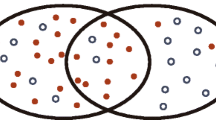Abstract
DAVID bioinformatics resources consists of an integrated biological knowledgebase and analytic tools aimed at systematically extracting biological meaning from large gene/protein lists. This protocol explains how to use DAVID, a high-throughput and integrated data-mining environment, to analyze gene lists derived from high-throughput genomic experiments. The procedure first requires uploading a gene list containing any number of common gene identifiers followed by analysis using one or more text and pathway-mining tools such as gene functional classification, functional annotation chart or clustering and functional annotation table. By following this protocol, investigators are able to gain an in-depth understanding of the biological themes in lists of genes that are enriched in genome-scale studies.








Similar content being viewed by others
References
Huang da, W. et al. DAVID bioinformatics resources: expanded annotation database and novel algorithms to better extract biology from large gene lists. Nucleic Acids Res. 35, W169–W175 (2007).
Dennis, G. Jr. et al. DAVID: database for annotation, visualization, and integrated discovery. Genome Biol. 4, P3 (2003).
Hosack, D.A., Dennis, G. Jr., Sherman, B.T., Lane, H.C. & Lempicki, R.A. Identifying biological themes within lists of genes with EASE. Genome Biol. 4, R70 (2003).
Zeeberg, B.R. et al. High-Throughput GoMiner, an 'industrial-strength' integrative gene ontology tool for interpretation of multiple-microarray experiments, with application to studies of common variable immune deficiency (CVID). BMC Bioinformatics 6, 168 (2005).
Beissbarth, T. & Speed, T.P. GOstat: find statistically overrepresented Gene Ontologies within a group of genes. Bioinformatics 20, 1464–1465 (2004).
Khatri, P., Bhavsar, P., Bawa, G. & Draghici, S. Onto-Tools: an ensemble of web-accessible, ontology-based tools for the functional design and interpretation of high-throughput gene expression experiments. Nucleic Acids Res. 32, W449–W456 (2004).
Martin, D. et al. GOToolBox: functional analysis of gene datasets based on Gene Ontology. Genome Biol. 5, R101 (2004).
Al-Shahrour, F., Diaz-Uriarte, R. & Dopazo, J. FatiGO: a web tool for finding significant associations of Gene Ontology terms with groups of genes. Bioinformatics 20, 578–580 (2004).
Masseroli, M., Galati, O. & Pinciroli, F. GFINDer: genetic disease and phenotype location statistical analysis and mining of dynamically annotated gene lists. Nucleic Acids Res. 33, W717–W723 (2005).
Lee, J.S., Katari, G. & Sachidanandam, R. GObar: a gene ontology based analysis and visualization tool for gene sets. BMC Bioinformatics 6, 189 (2005).
Subramanian, A. et al. Gene set enrichment analysis: a knowledge-based approach for interpreting genome-wide expression profiles. Proc. Natl. Acad. Sci. USA 102, 15545–15550 (2005).
Khatri, P. & Draghici, S. Ontological analysis of gene expression data: current tools, limitations, and open problems. Bioinformatics 21, 3587–3595 (2005).
Sherman, B.T. et al. DAVID knowledgebase: a gene-centered database integrating heterogeneous gene annotation resources to facilitate high-throughput gene functional analysis. BMC Bioinformatics 8, 426 (2007).
Huang da, W. et al. The DAVID gene functional classification tool: a novel biological module-centric algorithm to functionally analyze large gene lists. Genome Biol. 8, R183 (2007).
Huang, D.W., Sherman, B.T. & Lempicki, R.A. DAVID gene ID conversion tool. Bioinformation 2, 428–430 (2008).
Cicala, C. et al. HIV envelope induces a cascade of cell signals in non-proliferating target cells that favor virus replication. Proc. Natl. Acad. Sci. USA 99, 9380–9385 (2002).
Acknowledgements
We are grateful to the referees for their constructive comments and thank Robert Stephens, David Bryant and David Liu in the ABCC group for Web server support. Thanks also go to Xin Zheng and Jun Yang in the Laboratory of Immunopathogenesis and Bioinformatics (LIB) group for discussion. We also thank Bill Wilton and Mike Tartakovsky for information technology and network support. The project has been funded with federal funds from the National Institute of Allergy and Infectious Diseases (NIAID) and National Institutes of Health (NIH), under Contract no. NO1-CO-56000. The annotation of this tool and publication does not necessarily reflect the views or policies of the Department of Health and Human Services, nor does mention of trade names, commercial products or organizations imply endorsement by the United States Government.
Author information
Authors and Affiliations
Corresponding authors
Supplementary information
Supplementary Data 1.
Collection of ∼68 similar enrichment analysis tools. The tools are roughly categorized into three classes according to their backend algorithms. Reference links are provided for more information about each tool. (XLS 101 kb)
Supplementary Data 2.
∼400 Affymetrix IDs16 used in this paper (XLS 71 kb)
Supplementary Data 3.
Comparisons of the enrichment p-values between gene lists derived from microarray study vs. same size gene lists generated randomly. A 'good' gene lists should consistently contain more enriched biology than that of random list of the same sizes. (PDF 338 kb)
Supplementary Data 4.
Summaries of gene identifier types and annotation categories supported in the DAVID system. (XLS 38 kb)
Supplementary Data 5.
Screen shots of each major analysis step according to the description in the manuscript. (PDF 1600 kb)
Supplementary Data 6.
Examples for the input formats of a gene list. (PDF 69 kb)
Rights and permissions
About this article
Cite this article
Huang, D., Sherman, B. & Lempicki, R. Systematic and integrative analysis of large gene lists using DAVID bioinformatics resources. Nat Protoc 4, 44–57 (2009). https://doi.org/10.1038/nprot.2008.211
Published:
Issue Date:
DOI: https://doi.org/10.1038/nprot.2008.211
- Springer Nature Limited
This article is cited by
-
Splenic monocytes drive pathogenic subretinal inflammation in age-related macular degeneration
Journal of Neuroinflammation (2024)
-
Decoding dynamic miRNA:ceRNA interactions unveils therapeutic insights and targets across predominant cancer landscapes
BioData Mining (2024)
-
Genome-wide association study identifies genetic variants underlying footrot in Portuguese Merino sheep
BMC Genomics (2024)
-
Distinct regulatory networks control toxin gene expression in elapid and viperid snakes
BMC Genomics (2024)
-
NCAPD2 is a favorable predictor of prognostic and immunotherapeutic biomarker for multiple cancer types including lung cancer
Genes and Environment (2024)




